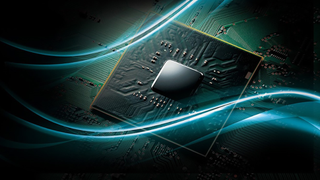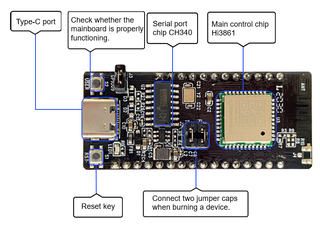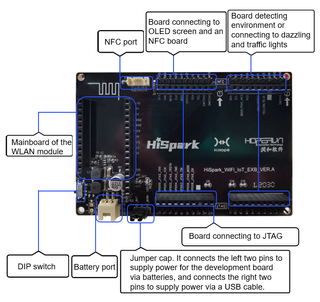Huawei's HiSilicon Develops First RISC-V Design to Overcome Arm Restrictions
Circumvention

In a bid to overcome US restrictions on its Arm designs, Huawei's HiSilicon has turned to the open-source RISC-V architecture and has even released its first RISC-V board for Harmony OS developers. Due to being blacklisted by the U.S. government, Huawei and its chip division HiSilicon do not have access to development and production technologies designed in America. The restrictions include many Arm processor architectures, including those used in various microcontrollers that Huawei uses widely.
HiSilicon's HiSilicon Hi3861 development board is based on the company's own Hi3861 controller. Huawei's documentation doesn't disclose exactly what the chip does, but it describes it as a main controller chip. The Hi3861 chip is accompanied by a serial port controller as well as a USB-C port. Among the more important aspects, the Hi3861 seems to have all the logic that enables USB-C functionality (e.g., synchronization and port alignment) and GPIO (general-purpose) pins.

Overall, the HiSilicon Hi3861 development board has rather vast (at least Raspberry Pi-like) capabilities, but not for a world that Huawei's HiSilicon is used to, at least in terms of public opinion.

The Hi3861 is aimed mostly at the IoT market, whereas HiSilicon's development efforts were historically aimed at high-margin smartphones, tablets, PCs, and embedded systems. But Huawei needs computing platforms to use for its other devices, so the HiSilicon Hi3861 is just what the doctor ordered at this time.
When it comes to high-volume products made by Huawei, a non-Arm-based chip makes exceptional sense and also gives the company experience working with an open-source architecture. Only time will tell if the company uses its RISC-V experience to develop other, more powerful devices.
Stay on the Cutting Edge
Join the experts who read Tom's Hardware for the inside track on enthusiast PC tech news — and have for over 25 years. We'll send breaking news and in-depth reviews of CPUs, GPUs, AI, maker hardware and more straight to your inbox.

Anton Shilov is a Freelance News Writer at Tom’s Hardware US. Over the past couple of decades, he has covered everything from CPUs and GPUs to supercomputers and from modern process technologies and latest fab tools to high-tech industry trends.
-
InvalidError One more small step toward China's CPU independence and technology blockades against it becoming useless.Reply -
escksu Hope USA will understand that with the vast resources China has, its only a matter of time before it develops all its technology needed and render USA restriction useless.....all these trade war did very little impact to China....Reply -
spongiemaster Reply
And all the lost revenue US companies are going to see from not servicing such as vast market isn't exactly going to benefit them either.escksu said:Hope USA will understand that with the vast resources China has, its only a matter of time before it develops all its technology needed and render USA restriction useless.....all these trade war did very little impact to China.... -
wr3zzz It will be so ironic if China leverages open source tech like RISC-V to develop a brand new global technology supply chain and took out Intel/AMD/Nvidia just as US leveraged PC to circumvent Japan's dominance in semiconductor and electronics during the 80s and took down Fujitus/NEC/Toshiba who were too busy building moats.Reply -
-Fran- Reply
On the upside, it would make X86 and ARMv# ISA's a bit less relevant going forward? :DInvalidError said:One more small step toward China's CPU independence and technology blockades against it becoming useless.
I mean, if China becomes a backer of RISC-V, I can see it having an explosive growth and that will drive innovation for devices produced in China for sure.
Android, since it's Linux at the heart, can be re-compiled for RISC-V I'm sure, or they can just fork it and use a variant they can open-source as well. Davlik, I'm not sure if it has RISC-V support though, but it shouldn't be hard to port it from ARM to it.
I don't even understand what the USA is trying by banning China from using ARM... Is it because most of the military contractors use ARM micro-controllers?
Cheers! -
InvalidError Reply
It is a combination of a couple of things, the most important ones being Biden continuing most of the trade war it inherited from the POOO, the usual slate of patent disputes and the USA's long-standing feud with Huawei more specifically.Yuka said:I don't even understand what the USA is trying by banning China from using ARM... Is it because most of the military contractors use ARM micro-controllers? -
DotNetMaster777 Open source architecture is always best choice !!Reply
I hope that Huawei is going to build more powerful devices with risc v !?!?! -
hotaru.hino The irony I'm seeing is if China uses RISC-V to make something powerful enough to be a threat to everyone else, they're not obligated to share it.Reply
Open architecture doesn't imply open implementation. -
-Fran- Reply
Unless it has a military aspect to it, considering the way copyright works in China, they can't keep other Companies from using the designs they come up with (the companies); in their own territory even.hotaru.hino said:The irony I'm seeing is if China uses RISC-V to make something powerful enough to be a threat to everyone else, they're not obligated to share it.
Open architecture doesn't imply open implementation.
I can't remember exactly how it was in all fairness, but it was interesting.
Regards,
Most Popular





